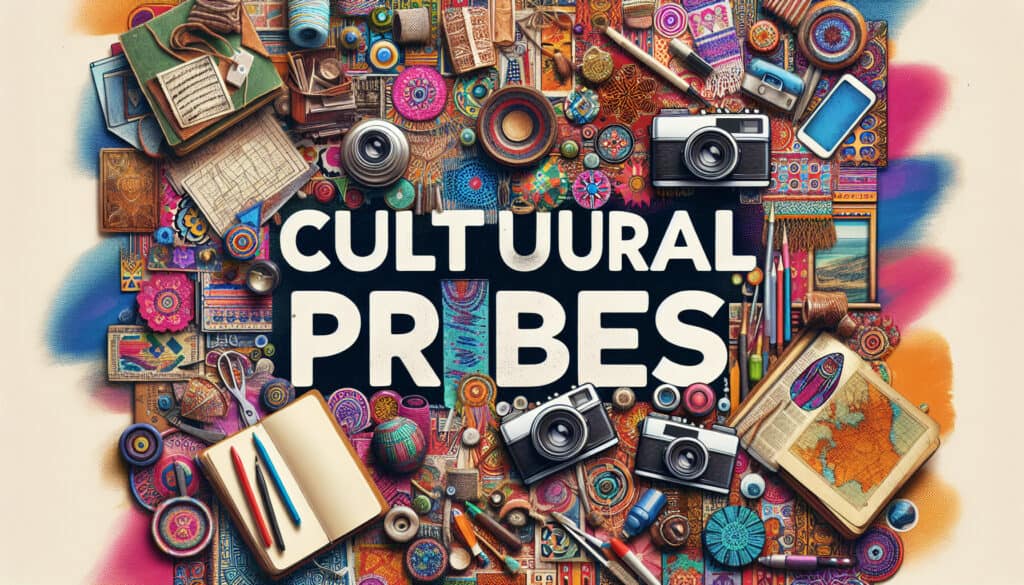A design-led research Verfahren that uses kits of artifacts (e.g., disposable cameras, diaries, maps) given to participants to inspire responses and gather insights about their lives and cultures.
- Methodologien: Kunden & Marketing, Wirtschaft
Cultural Probes

Cultural Probes
- Kreativität, Entwurfsprozess, Design Denken, Human-Centered Design, Ideenfindung, Prototyping, Benutzerzentriertes Design
Zielsetzung:
Wie es verwendet wird:
- The probes are left with participants for a period of time for them to self-document their experiences. The returned materials are used as inspiration for the design process, not as objective data.
Vorteile
- Provides inspirational and often surprising insights into users' lives and values; empowers participants to report on their own terms; generates rich, qualitative material that sparks creativity.
Nachteile
- The data is subjective, fragmented, and not intended for systematic analysis; it's not a method for answering specific questions but for generating inspiration; can be expensive to produce the kits.
Kategorien:
- Kunden & Marketing, Ideenfindung, Produktdesign
Am besten geeignet für:
- Gaining empathic and inspirational insights into the lives and contexts of users to inspire the design process.
Cultural Probes typically come into play during the early stages of design projects where understanding the user’s context and emotional landscape is paramount. This methodology has found its footing primarily in fields such as interaction design, user experience research, and service design, where the human factors behind product interaction significantly influence outcomes. Ideal participants for Cultural Probes can include diverse user groups, from everyday consumers to specific segments such as healthcare users or technology adopters. Companies in industries ranging from consumer electronics to urban design frequently employ this methodology, as it surfaces nuanced user behaviors and latent needs that quantitative surveys might overlook. The period during which participants engage with the probes allows them to reflect on their day-to-day experiences, leading to a rich tapestry of qualitative data that can mimic storytelling. This can manifest in various outputs, such as photographs, sketches, or diary entries—all of which provide a contextually embedded view of the user’s life. The low-pressure nature of this self-documentation invites authenticity and enables users to engage with the process on their own terms, yielding materials that can inform design ideation sessions, co-creation workshops, or iterative prototyping. These unique insights can guide project teams to evolve their design parameters based not only on user preferences but also on the deeper cultural and emotional dimensions shaping user interactions with products and services.
Die wichtigsten Schritte dieser Methodik
- Design and create the probes, ensuring they encourage open-ended responses.
- Distribute probes to selected participants, explaining their purpose and usage.
- Participants engage with probes over a designated period, documenting their experiences and thoughts.
- Collect and analyze the returned materials for themes and patterns.
- Utilize findings from the probes to inform and inspire the design process.
Profi-Tipps
- Encourage participants to explore unconventional mediums for documentation, such as audio recordings or drawings, to capture emotions and nuances that words might miss.
- Set specific themes or prompts for each probe to guide participants while still allowing freedom for personal expression, ensuring rich and varied narratives.
- Facilitate a debrief session post-return of materials to elicit deeper discussions and clarify ambiguous content, enriching the contextual understanding of collected materials.
Verschiedene Methoden lesen und vergleichen, Wir empfehlen die
> Umfassendes Methoden-Repository <
zusammen mit den über 400 anderen Methoden.
Ihre Kommentare zu dieser Methodik oder zusätzliche Informationen sind willkommen auf der Kommentarbereich unten ↓ , sowie alle ingenieursbezogenen Ideen oder Links.
Historischer Kontext
1986
(wenn das Datum nicht bekannt oder nicht relevant ist, z. B. "Strömungsmechanik", wird eine gerundete Schätzung des bemerkenswerten Erscheinens angegeben)

Verwandte Artikel
METS-Kalorien-Rechner
Meta-Analyse
Nachrichten-Mapping
Mentalmodell-Diagramme
Maximal zulässige Druck- und Zugkräfte
Materialbedarfsplanung (MRP)